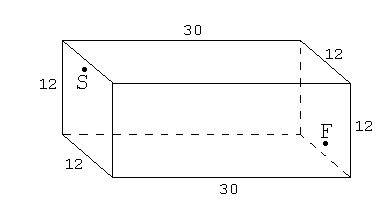Part 1:
There is a rectangular room whose dimensions are 30' long
by 12' wide by 12' high. A spider is located on one of
the 12'x12' end walls 1' down from the ceiling and 6' from
each side wall. A fly is located on the opposite 12'x12' wall
1' up from the floor and 6' from each side wall.
The spider desires to dine on the fly which is asleep. Determine the
shortest route that the spider may follow to get to the fly
(the spider must always be touching one of the 4 walls, the ceiling,
or the floor). The shortest route is defined to be the least number
of feet from S to F.

The intuitive answer is 42 feet, by going down 11 feet to the floor, then over 30 feet, and then up 1 foot. However,
the shortest distance is actually 40 feet, and the spider will cross over five of the six faces of the room!! One of
my students built a wooden model of this problem for me, and I used it every year to show the actual path of the spider! The
model was built with 5 pieces of wood with one wall open so that you could see.
The best way to solve this problem is to make an orthographic drawing of the room by unfolding the walls.
Here is what the intuitive drawing would look like:

There are four different ways to unfold the room, and you should have your students do all of them. Here
is the way that yields the shortest distance:

As you can see, the shortest distance is the hypotenuse of the right traingle whose legs are 32 ft and 24 ft.
This is a multiple of the 3-4-5 triangle, so the hypotenuse is 40 feet.
Part 2:
Another spider desires to dine on another fly. The
spider begins at point A and must travel along the paths
of her web to get to the fly at point B. To work up an appetite
for dinner, the spider decides to challenge herself by turning either
left or right at every intersection
including the ones encountered right at the start and finish (points
A and B), never going straight across. Still, she is eager to get to
Mr. Fly, so she determines to take the shortest route. Can you help her
find the shortest route to dinner? The shortest
route is determined by the least number of turns made to get from A to B.
The least number of turns is 26. Here is the route:
